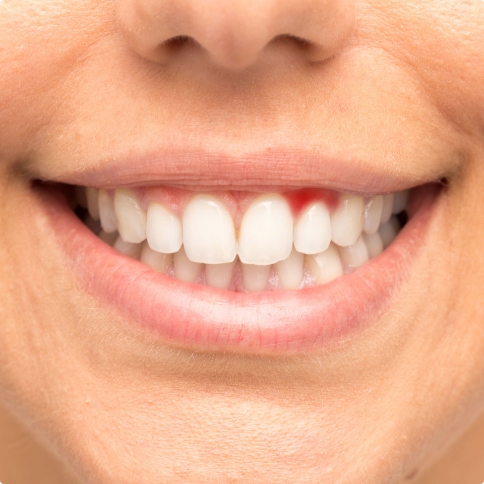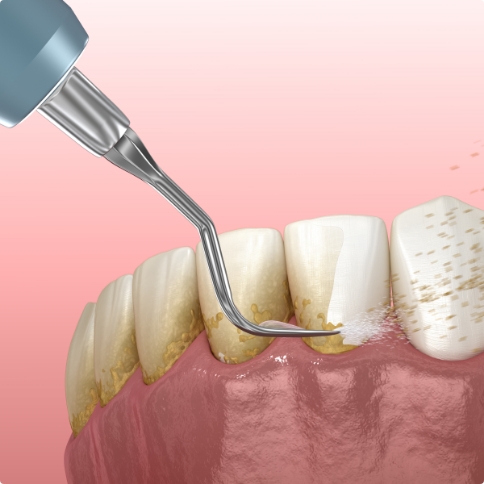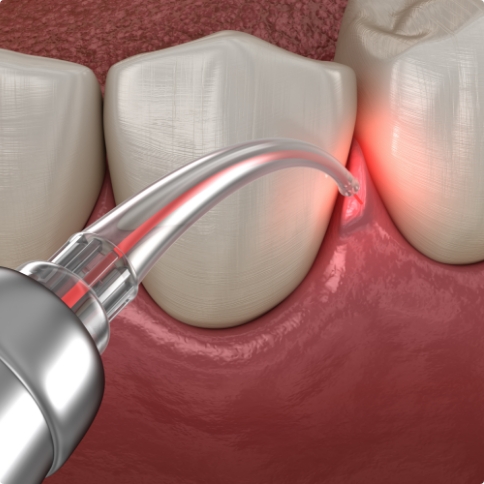Gum Disease Treatment – Weatherford, TX
Protect Your Oral & Overall Health
Gum disease. These two words can mean very serious trouble for your smile. When your gums are unhealthy, it can lead to extensive damage and, eventually, tooth loss. Your gums work together with your jawbone to hold your teeth in place. As they erode, it can leave your teeth feeling loose. Gum disease also contributes to bone loss as it advances, and the infection can spread to other parts of the body, influencing heart health and contributing to diabetes and other health problems. For our patients at Cosmetic and Family Dentistry of Weatherford, our hygienists provide non-surgical gum disease treatment in Weatherford to help patients with gum disease rediscover their oral health.
Gum disease isn't just one of the most common oral health problems -- it's one of the most common diseases in general! Many people have gum disease and don't realize it, usually because they don't recognize the symptoms. The first line of defense is regular dental checkups and cleanings, which give us the chance to prevent and diagnose your gum disease for early intervention and treatment if necessary. This process will generally involve non-surgical gum disease treatment.
If you notice bleeding gums, don't ignore this common telltale sign of gum disease! Come and see the team at Cosmetic and Family Dentistry of Weatherford, where we happily serve families from Aledo, Brock, Millsap, Mineral Wells, and Springtown, Texas, too.
Why Choose Cosmetic & Family Dentistry of Weatherford for Gum Disease Treatment?
- Laser Therapy Used to Eliminate Bacteria
- Sedation Dentistry Available
- Compassionate Dental Team
How Does Gum Disease Happen?

In a word, the problem is plaque and biofilm, which is a sticky substance that develops in the mouth every day. When bacteria in plaque accumulate along the gumline, they can begin to irritate this soft tissue. Eventually, you may notice swelling, sensitivity, and bleeding when you brush. Interestingly, not brushing or flossing well is often what causes gum disease to start. So, if you do see bleeding when you clean your teeth at home, continuing to brush and floss regularly may be the key to reversing the initial effects of early gum disease, called gingivitis.
Besides bleeding gum tissue, other symptoms of gum disease include:
- Frequent bad breath
- Loose teeth
- Receding gum line
- Tooth loss
In fact, advanced gum disease—called periodontitis—is the leading cause of tooth loss among American adults. The disease not only devastates gum tissue but also weakens the bone structure that supports your teeth. In extreme cases, teeth may need to be extracted.
Scaling & Root Planing

If you develop an advanced case of gum disease, one of the ways we can treat it is with a procedure called scaling and root planing.
For scaling, your hygienist will use small manual tools to remove accumulated plaque, tartar and bacteria from below your gum line. Most of it will be gathered in periodontal pockets, which are the small spaces between your teeth and your gums. This is where gum disease typically develops, and scaling is used to treat the source of the infection.
Afterward, root planing involves gently shaping the roots of your teeth to smooth them out. This serves two purposes. Firstly, it makes it much harder for plaque, tartar and bacteria to gather there in the future. Secondly, it helps in the healing process and makes it easier for your gum tissue to reattach to your teeth. A patient will feel very little discomfort while undergoing scaling and root planing, and most of the time, the procedures can be completed in just one to two visits.
Soft Tissue Laser Treatment

Another option we have for treating gum disease is with a soft tissue laser. The Picasso Diode Laser can clear away plaque and bacteria from below the gum line in conjunction with scaling and root planing, increasing the healing time and enhancing the results from the procedure. What does that mean? It means the procedure itself is practically painless, and your recovery time will be extremely short. It truly is one of the most patient-friendly ways to treat gum disease.
I Need a Checkup & Cleaning I Need Help with a Lip and/or Tongue-Tie I Have a Cavity or Broken Tooth I am Missing One or More Teeth I Want to Enhance My Smile I Want a Straighter Smile I Have Jaw Pain I am Scared of the Dentist I'm Having Trouble Sleeping I Have a Dental Emergency View Our Services
